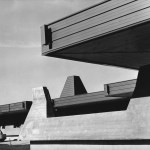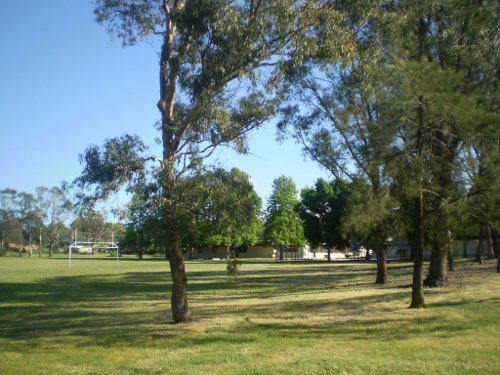Architect Enrico Taglietti talks with ABC Stateline presenter Chris Kimble about Flynn Primary School
Architect Enrico Taglietti’s support for the Flynn Primary School and community centre was highlighted in an ABC Stateline story tonight (Friday 29 May).
The video is online here: http://www.abc.net.au/news/video/2009/05/29/2584987.htm
Transcript
(From the ABC Stateline website, with errors corrected)
CHRIS KIMBALL, PRESENTER: I have to declare an interest regarding this story. I was a student at Flynn Primary School in the 1980s, and like many people in that community, was sad to see it shut its doors. What’s even more distressing is to see the state of the school now, almost three years since it was closed. Flynn was a unique school. It featured an innovative open planned layout and was the suburb’s only community facility. I returned to the school this week with its designer, the award winning architect Enrico Taglietti.
So, Enrico, here we are at the front of Flynn Primary – what was Flynn Primary, I guess.
ENRICO TAGLIETTI, ARCHITECT: It was. No children and no life at the moment on the school.
CHRIS KIMBALL: How important was this place in the context of your work?
ENRICO TAGLIETTI: In the context of my work was one of the most important building that I ever design.
CHRIS KIMBALL: What made this school unique when it was in its prime?
ENRICO TAGLIETTI: Um, Chris, that school was unique because it was the only public building within the Flynn context and it should have been designed generally for not only as a school internally, but as a village outside.
CHRIS KIMBALL: As a real community hub.
ENRICO TAGLIETTI: As a real complete community.
CHRIS KIMBALL: What’s it like as an architect to come back to a place that you were a big part of and see it like this, to see it as a ghost town, I guess?
ENRICO TAGLIETTI: It’s sad, but at the same time may give me time to reflection, to contemplation.
CHRIS KIMBALL: So you remember this place in its prime, with kids, just as I do, having been a student here.
ENRICO TAGLIETTI: Yes, I remember that one as full of life, you know screams, singing, children playing around.
CHRIS KIMBALL: Especially in these communal (inaudible)?
ENRICO TAGLIETTI: Yes. But, today, although it feels like being in a book without life, without population, the graffiti over there, but the architecture has not been destroyed, which is great, to a certain extent. The building is still very valid, very useable, and therefore should be maintained partly as a school, partly for community.
CHRIS KIMBALL: That vision for the future is shared by the Flynn community.
ROGER NICHOLL, FLYNN PRIMARY SCHOOL P&C: Well essentially our proposal for Flynn is for a school, childcare and community centre that works together. So it’s a multi use facility. It’s a new way of bringing life back into the Flynn community. We believe it’ll be totally viable and sustainable.
CHRIS KIMBALL: Despite almost three years of failed legal action and expensive and exhaustive protests, the Flynn group hasn’t given up. It says this school was unique in design and in its community context.
ROGER NICOLL: It is a ghost school, a ghost centre of the suburb because it was our community facility, it was our heart, our hub. That makes Flynn quite different from other places where schools were closed because most of those had other community facilities where people could gather and connect, whereas Flynn we had the school and that was it. And so when that closed it really it closed down the suburb in a social sense.
CHRIS KIMBALL: Some former school sites have been identified for aged care facilities and parks. Others are already hubs for community use.
Flynn has been a key battleground on this issue, legally and personally. This site’s future remains in limbo, perhaps in part because the local community is not willing to compromise.
ROGER NICOLLL: Quite devastating to walk around the school now and remember what it used to be like and how it was the heart of the suburb and full of kids and full of life and community activities and to see the graffiti and the smashed windows, it really is heart-breaking.
CHRIS KIMBALL: Vandalism is a problem at many former school sites across Canberra. The closed schools are now under the control of Territory and Municipal Services. In a statement, TAMS said that vandalism a particular concern at the Flynn site and that security patrols are frequent, and specifically in relation to the site’s future, that an assessment that is currently before the ACT Heritage Council which may influence future use options.
So there’s still hope in the Flynn community that this isn’t the end and it’s not gonna continue to degrade like it has been degraded?
ROGER NICHOLLL: We’re certainly hopeful that the current school closure inquiry will bring some good results, and we’re hopeful that the proposal that we’ve put on the table will be met with, you know, a good response from all parties.
CHRIS KIMBALL: If someone said they were going to knock the school down and put units or medium density housing, how would you react?
ENRICO TAGLIETTI: I would react most probably with a small revolution pull down the assembly.
CHRIS KIMBALL: That’s certainly not on their plans at the moment, though.
ENRICO TAGLIETTI: At least not in mine either. But it could be.




